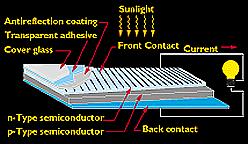

Assignment Introduction:
Photovoltaic (or PV) systems convert light energy into electricity. The term "photo" is a stem from the Greek "phos," which means "light." "Volt" is named for Alessandro Volta (1745-1827), a pioneer in the study of electricity. "Photo-voltaics," then, could literally mean "light-electricity." Most commonly known as "solar cells," PV systems are already an important part of our lives. The simplest systems power many of the small calculators and wrist watches we use every day. More complicated systems provide electricity for pumping water, powering communications equipment, and even lighting our homes and running our appliances. In a surprising number of cases, PV power is the cheapest form of electricity for performing these tasks.
Invitation:
You've probably seen calculators that have solar cells - calculators that never need batteries, and in some cases don't even have an off button. As long as you have enough light, they seem to work forever. You may have seen larger solar panels - on emergency road signs or call boxes, on buoys, even in parking lots to power lights. Although these larger panels aren't as common as solar powered calculators, they're out there, and not that hard to spot if you know where to look. You have also seen solar cell arrays on satellites, where they are used to power the electrical systems.
You have probably also been hearing about the "solar revolution" for the last 20 years - the idea that one day we will all use free electricity from the sun. This is a seductive promise - on a bright, sunny day the sun shines approximately 1,000 watts of energy per square meter of the planet's surface, and if we could collect all of that energy we could easily power our homes and offices for free.
Scenario: It is a fact that the United States is the major consumer of oil energy products in the world. Imagine that the OPEC Nations decided to raise the price of oil by $50.00 per barrel. In an effort to reduce the United States dependency on foreign oil, our government decides to offer tax breaks to its citizens who develop and use other forms of energy such as solar, wind, and alcohol. You are planning to build a new home. How would you design your house to include and take advantage of solar energy?
Exploration:
Students are to gather information on solar heating from a variety of sources that include the following:
Activity: Timeline: 1-2 weeks
Objectives:
Students are to define the following terms: